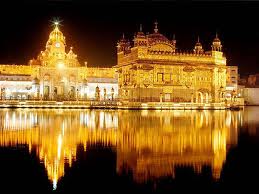The Indian State of Punjab
Punjab is the Home of the Sikhs
Where does the Name Punjab come from?
The Indian State of Punjab is located in India's Northern Region. The name Punjab has two meanings in reference to India. It refers both to a geographical region that borders northern India and Pakistan, and to the specific Indian state that lies within the Republic of India. The name is of Persian origin and means land of five waters. It got its name because the Jheium, Chenab, Ravi, Sutlej and Beas Rivers all run through the region. These rivers all birth from the Indus River. This area is important to ancient Indian culture and ancient Indian history because it is organically linked to the Indus Valley Civilizations, like that of the Harappa people.
The states of India covered by this region of India are the Punjab, Haryana, Himachal Pradesh, Chhandigarh, and Delhi. The state of Punjab is bordered to its east by Himachal Pradesh, to its south by Haryana, Rajasthan and the Pakistan Province to its southwest. To its north, it is bordered by the States of Jamu and Kashmir.
The History of the Indian State of Punjab
After the partition of India in 1947, the region was broken into the Pakistan and India sections. The Indian section was structured in 1966 and the primary language spoken here is Punjabi.
This is India's only state with a large number of Indians following the Sikh religion. The history in the region involves a lot of conflict. A conqueror known as Babur took over northern India during the time of the Mughal Empire. His grandson, Akbar was a powerful ruler and strong supporter Sikhism. He donated land for Sikh use and had a strong relationship with the Sikh Gurus. When Akbar passed away in 1605, his successor, Jahangir thought the Sikhs were a political threat. He jailed Sikh Guru Amar Das, and had him tortured to death.
The death of Guru Amar led to Guru Har Gobind declaring Sikh sovereignty. He established the Amritsar Fort and created the Akai Takht (throne of god) within its walls. Akai Takht was also an organization of Sikh religious independence. Guru Gobind protected the fortress and Sikh religious rights from countless attacks. Some attacks were from Muslim rulers who wanted to impose Islam on the land. Regardless, Sikhism still stands as the primary religion of the state today.
The state's strongest industry is agriculture. In fact, it's India's largest provider of wheat. In addition, scientific instruments, electrical goods, machine tools, textiles, sewing machines, sports equipment, fertilizers, bicycles, pine oil, sugar and starch are produced here. This state also boasts the largest number of steel rolling mills in its city of Mandi Gobindgarh.
The geographic region is subject to extreme hot and extreme cold conditions, and has three seasons; Summer, Winter and Monsoon. It has some of India's best plant and wildlife varieties. It has roughly 350 different herbs, 70 trees, 70 shrub species, 396 species of birds, 55 fish varieties, 20 reptiles, and 19 species of different mammals.
In ancient India, the region was called Panchanada, and housed important civilizations like Harappa. Visit our Ancient India Culture and History pages to discover more on this crucial era.
The state has the lowest level of hunger in India according to the 2008 India State Hunger Index.
Tourist come here to see on the historic palaces, locations of battles, and Sikh architecture. The Indus Valley Civilization sites, the ancient fort of Bathinda, the monuments of Kapurthala, Patiala, Chandigarh, and the modern capital are some major attractions. The Golden Temple in Amritsar is not only the state's main tourist attraction, it's one of India's main tourist attractions. In fact, it actually brings in more visitors than the Taj Mahal! Leave Punjab to discover the other Indian states and union territories. Visit our homepage to explore more of India.



